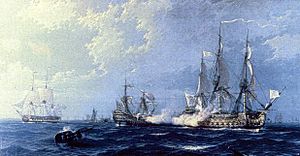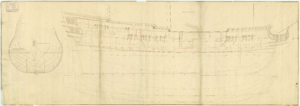HMS Kent (1679) facts for kids

Battle between the Spanish 70-gun Princesa (right foreground), and HMS Lenox, Orford and Kent, 8 April 1740
|
|
Quick facts for kids History |
|
|---|---|
| Name | HMS Kent |
| Ordered | 20 February 1678 |
| Builder | Sir Henry Johnson of Blackwall |
| Launched | 1679 |
| Commissioned | 25 September 1679 |
| Honours and awards |
|
| Fate | Breaking completed at Chatham December 1744 |
| General characteristics as built | |
| Class and type | 70-gun third rate ship of the line |
| Tons burthen | 1,03975⁄94 tons (bm) |
| Length |
|
| Beam | 40 ft 1.5 in (12.23 m) |
| Draught | 18 ft 0 in (5.49 m) |
| Depth of hold | 16 ft 9.5 in (5.12 m) |
| Propulsion | Sails |
| Sail plan | Full-rigged ship |
| Armament |
|
| General characteristics after 1699 rebuild | |
| Class and type | 70-gun third rate ship of the line |
| Tons burthen | 1,06530⁄94 tons (bm) |
| Length |
|
| Beam | 40 ft 3 in (12.27 m) |
| Depth of hold | 16 ft 7 in (5.05 m) |
| Propulsion | Sails |
| Sail plan | Full-rigged ship |
| Armament |
|
| General characteristics after 1724 rebuild | |
| Class and type | 70-gun third rate ship of the line |
| Tons burthen | 1,06574⁄94 tons (bm) |
| Length |
|
| Beam | 41 ft 6 in (12.6 m) |
| Depth of hold | 17 ft 4 in (5.3 m) |
| Propulsion | Sails |
| Sail plan | Full-rigged ship |
| Complement | 440 personnel |
| Armament |
|
HMS Kent was a powerful 70-gun ship of the line built for the English Royal Navy. She was launched in 1679 and served for many years, taking part in several important battles. These included the Battle of Barfleur and the Battle of Vigo Bay.
Like many ships of her time, HMS Kent was rebuilt twice during her life. These rebuilds helped keep her strong and ready for duty. She was finally taken apart in 1744. HMS Kent was the second ship to carry this name in the Royal Navy.
HMS Kent earned special recognition for her bravery in battle. These "Battle Honours" include:
- Barfleur 1692
- Vigo 1702
- Velez-Malaga 1704
- Passero 1718
Contents
Building a Warship: HMS Kent's Design
HMS Kent was ordered on February 20, 1678. She was built by Sir Henry Johnson in Blackwall, England, and launched in 1679. She was a large sailing ship, about 46 meters (151 feet) long on her main gun deck. She weighed around 1,039 tons.
Original Guns and Crew
When first built, HMS Kent carried 70 guns. These included:
- 26 large cannons on the lower deck.
- 26 medium cannons on the upper deck.
- 10 smaller cannons on the quarterdeck.
- 4 smaller cannons on the forecastle.
- 4 very small guns on the poop deck.
Her crew usually had between 300 and 460 sailors and officers.
HMS Kent's Active Service
HMS Kent had a long and busy career, serving in many important conflicts.
Early Years: 1679 to 1697
HMS Kent began her service on September 25, 1679. She was commanded by several captains over the years. In 1692, she fought bravely in the Battle of Barfleur. This was a major naval battle during the Nine Years' War. She also took part in battles near Cherbourg and La Hogue. After years of service, she was taken out of active duty in May 1697 to be rebuilt.
First Rebuild: 1697-1699
From 1697 to 1699, HMS Kent was rebuilt at Rotherhithe. This was a common practice for warships to keep them strong and up-to-date. After the rebuild, she was slightly larger, weighing about 1,065 tons. She still carried at least 70 guns.
Fighting in the Spanish Succession War: 1699 to 1722
In 1699, HMS Kent returned to service. In 1702, she joined Admiral Sir George Rooke's fleet. They sailed to Cadiz, Spain, and later to Vigo Bay. At the Battle of Vigo Bay on October 12, 1702, the Anglo-Dutch fleet attacked and destroyed many French and Spanish ships.
In 1704, under Captain Jonas Hanway, she helped capture two Spanish ships, Porta Coeli and Santa Teresa. She then fought in the Battle of Velez-Malaga on August 13, 1704. This was a fierce battle where HMS Kent had 15 sailors killed and 26 wounded.
She continued to serve in the Mediterranean Sea. In 1710, she captured a French ship called Le Superbe. After the War of Spanish Succession ended, she underwent a major repair between 1714 and 1715.
In 1718, HMS Kent captured the Spanish ship Santa Rosalia near Corfu, Greece. She also captured the San Carlos at the Battle of Passaro near Sicily on August 11, 1718. She stayed in service during a short war with Spain. In 1722, she was taken apart at Woolwich Dockyard to be rebuilt again.
Second Rebuild: 1722 to 1726
HMS Kent was rebuilt at Woolwich Dockyard starting in 1722 and was launched again in 1724. This rebuild made her even stronger. She was now about 1,129 tons.
Her new set of 70 guns included:
- 26 powerful 24-pounder guns on the lower deck.
- 26 12-pounder guns on the upper deck.
- 14 6-pounder guns on the quarterdeck.
- 4 6-pounder guns on the forecastle.
Her crew size was set at 440 people. She was ready for sea in May 1726.
Later Service: 1726 to 1744
After her second rebuild, HMS Kent served with various fleets. She sailed to the Straits of Gibraltar and off the coast of Spain. For many years, she acted as a "guard ship" at Portsmouth, protecting the harbor.
In 1739, she sailed with a squadron off Cape Finisterre. In 1740, she was part of a group of ships that spotted the Spanish 64-gun ship Princesa. On April 8, 1740, HMS Kent, along with HMS Lenox and HMS Orford, captured the Spanish ship.
Later, she escorted a convoy to the West Indies in 1741. She was involved in operations near Santiago and Porto Bello. Her last battle was in 1744, when she bombarded Spanish positions in Santiago de Cuba in the West Indies. After this, she returned home.
End of Service
HMS Kent was ordered to be replaced by a new ship in May 1743. When she returned to England, she was taken out of service. Her dismantling began in November 1744 and was completed in December 1744 at Chatham.


